#galaxy clusters
Explore tagged Tumblr posts
Text
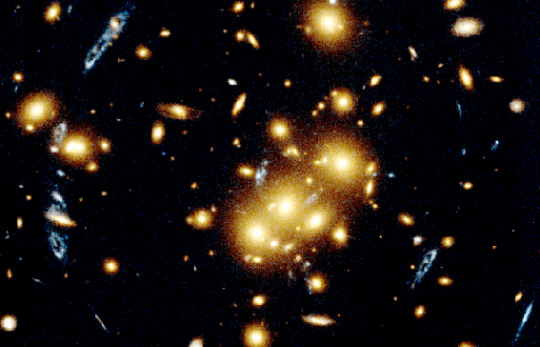
Giant Cluster Bends, Breaks Galaxy Images - May 3rd, 1997.
"What are those strange blue objects? Many are images of a single, unusual, beaded, blue, ring-like galaxy, which just happens to line up behind a giant cluster of galaxies. Cluster galaxies here appear yellow and - together with the cluster's dark matter - act as a gravitational lens. A gravitational lens can create several images of background galaxies, analogous to the many points of light one would see while looking through a wine glass at a distant street light. The distinctive shape of this background galaxy allowed astronomers to deduce that it has separate images at 4, 8, 9 and 10 o'clock, from the center of the cluster. Possibly even the blue smudge just left of the center is yet another image! This spectacular photo from HST was taken in October, 1994. The first cluster lens was found unexpectedly by Roger Lynds (NOAO) and Vahe Petrosian (Stanford) in 1986 while testing a new type of imaging device. Lensed arcs around this cluster, CL0024+1654, were first discovered from the ground by David Koo (UCO Lick) in 1988."
#nasa#space#cosmos#universe#astronomy#astrophysics#astrophotography#galaxies#galaxy clusters#dark matter#gravitational lensing
41 notes
·
View notes
Text
Progress flag colorpicked from MACS 0416 galaxy cluster with gravitationally lensed star Mothra


#color picked flags#color picked pride flags#james webb space telescope#jwst#color picked#colorpicked#colorpicked flags#colorpicked pride flags#jwst images#space#nasa#flags#pride flags#pride#pride month#pride 2025#pride month 2025#queer pride#lgbt pride#lgbtq pride flag#lgbtq#lgbtq community#queer#progress pride flag#galaxy#galaxies#galaxy cluster#galaxy clusters#star#stars
50 notes
·
View notes
Text
"Astronomers have discovered a huge filament of hot gas bridging four galaxy clusters. At 10 times as massive as our galaxy, the thread could contain some of the Universe’s ‘missing’ matter, addressing a decades-long mystery."
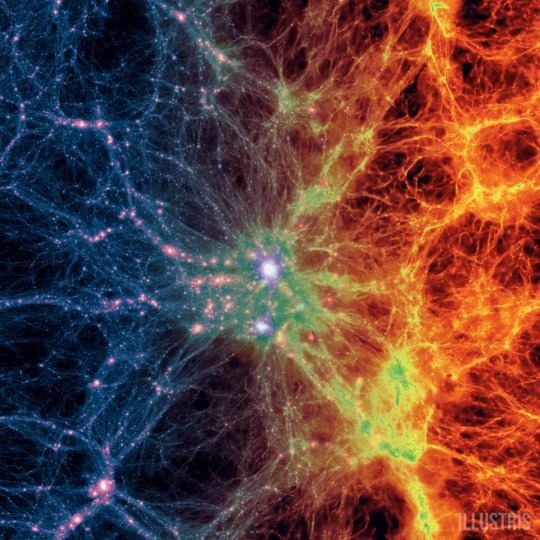
(Simulation of the cosmic web- credit)
"Over one-third of the ‘normal’ matter in the local Universe – the visible stuff making up stars, planets, galaxies, life – is missing. It hasn’t yet been seen, but it’s needed to make our models of the cosmos work properly.
Said models suggest that this elusive matter might exist in long strings of gas, or filaments, bridging the densest pockets of space. While we’ve spotted filaments before, it’s tricky to make out their properties; they’re typically faint, making it difficult to isolate their light from that of any galaxies, black holes, and other objects lying nearby.
New research is now one of the first to do just this, finding and accurately characterising a single filament of hot gas stretching between four clusters of galaxies in the nearby Universe.
As well as revealing a huge and previously unseen thread of matter running through the nearby cosmos, the finding shows how some of the densest and most extreme structures in the Universe – galaxy clusters – are connected over colossal distances.
It also sheds light on the very nature of the ‘cosmic web’, the vast, invisible cobweb of filaments that underpins the structure of everything we see around us."
continue reading article
#astronomy#cosmology#esa#cosmic web#universe#space#interconnectedness#connection#energy#plasma#density#matter#plasma physics#filaments#plasma filaments#myriad#structure#galaxies#galaxy clusters#threads#scale#science
2 notes
·
View notes
Text
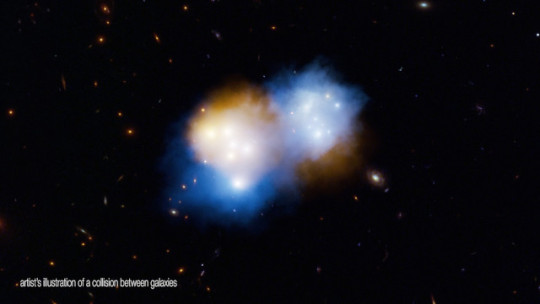
An article published in the journal "The Astrophysical Journal" reports the results of a study on the ongoing merger between two galaxy clusters that are forming a single new cluster cataloged as MACS J0018.5+1626, or simply MACS J0018.5. A team of researchers used data obtained from observations dating back even decades conducted with various space and ground-based telescopes, analyzing them to decouple the behavior of ordinary matter and dark matter.
To measure the speed of intergalactic gas composed of normal matter, they used the kinematic Sunyaev-Zel'dovich (SZ) effect. The speed of dark matter is roughly the same as galaxies. The result is that dark matter moves faster than normal matter. This result offers clues about dark matter and its behavior that are useful in studies of its nature.
8 notes
·
View notes
Text
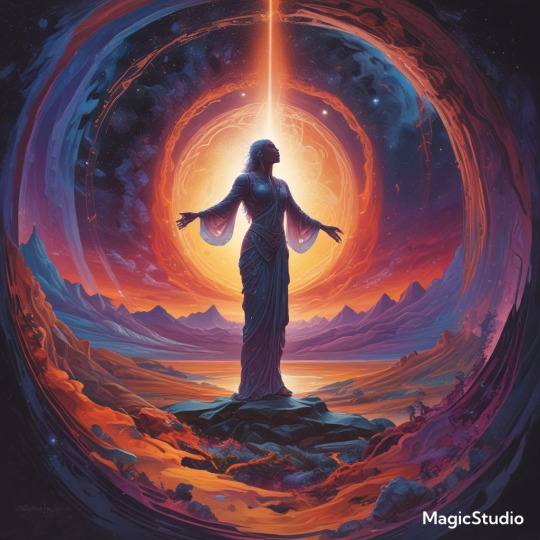
Unveiling the Cosmic Dance: From Milkomeda to Laniakea, Across the Vast Void
The vastness of the universe is impressive. It consists of billions of galaxies that extend over billions of light years. But within this immense expanse, our cosmic neighborhood, the so-called local universe, has a special significance. Here we find our home galaxy, the Milky Way, and countless other celestial bodies that shape our understanding of the cosmos. Let's embark on a journey through the local universe and explore the fascinating structures of galaxy groups, clusters and superclusters and their role in the larger structure of the cosmos.
Our immediate cosmic family is the Local Group, a collection of galaxies held together by gravity. This small-scale structure consists of the Milky Way, the Andromeda Galaxy (M31), the Triangulum Galaxy (M33), and about 50 dwarf galaxies. Although the Local Group may seem insignificant compared to the vastness of the Universe, it is a crucial laboratory for studying galaxy interactions and dynamics.
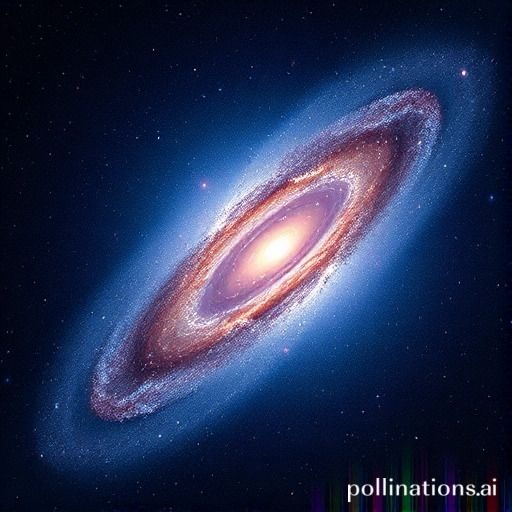
The Andromeda Galaxy, our nearest large star neighbor, is a stunning sight in the night sky. With its spiral arms and bright core, M31 is a prominent feature of the constellation Andromeda. The May 10, 2009 Astronomy Picture of the Day shows M31 and its companion, the elliptical galaxy M32, providing a stunning visual representation of the beauty and complexity of the Local Group.

One of the most fascinating aspects of the Local Group is the future collision between the Milky Way and the Andromeda Galaxy. In about 4.5 billion years, these two majestic galaxies will merge and form a new entity called "Milkomeda." This cosmic event highlights the dynamic nature of galactic interactions and the ever-evolving nature of our local Universe.
As we expand our view beyond the Local Group, we encounter larger and more diverse structures - galaxy groups and clusters. These are collections of galaxies held together by the gravitational forces that shape the Universe. Galaxy groups and clusters come in different sizes and densities, and each offers unique insights into the evolution and behavior of galaxies.
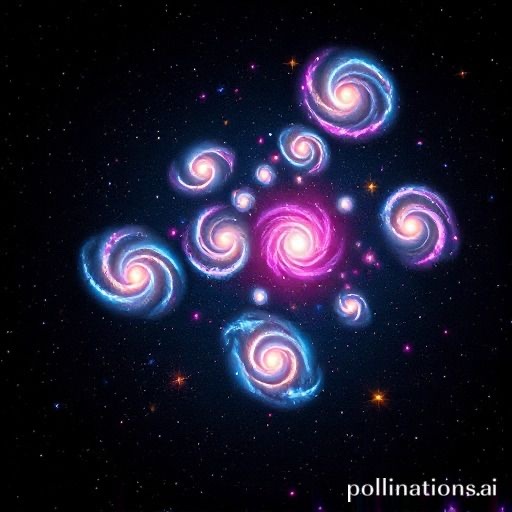
Paul Hickson identified Hickson Compact Groups as small, dense collections of galaxies. These groups are of particular interest because of their potential for galaxy mergers and interactions. In such a small space, galaxies can be subject to tidal forces, gas ejection and gravitational perturbations, leading to the formation of new types of galaxies and the reshaping of existing ones.

The Virgo Cluster is a prominent galaxy cluster in the local Universe, located in the constellation Virgo. It is a rich cluster containing thousands of galaxies, including giant elliptical galaxies and numerous spiral galaxies. The Virgo Cluster is a prime example of how galaxies gather and interact in a dense environment, influencing each other's evolution.
Rich galaxy clusters are cosmic giants containing thousands to tens of thousands of galaxies and huge amounts of hot gas. These clusters are not only impressive in size, but also crucial for understanding the distribution of matter in the universe and the role of dark matter.
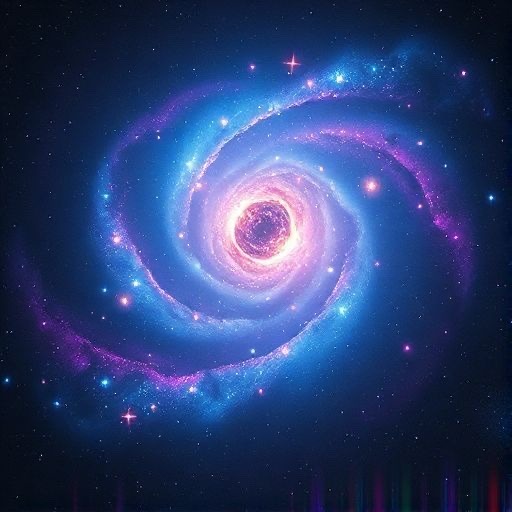
The Coma Cluster in the constellation Coma Berenices is a remarkably rich galaxy cluster. It is one of the most distant objects visible to the naked eye and contains a diverse population of galaxies. The high density of galaxies and the hot gas within the cluster make the Coma Cluster an ideal laboratory for studying cluster dynamics and the effects of gravitational interactions on galaxy evolution.

The Abell Catalog, compiled by astronomer George Abell, is a comprehensive list of rich galaxy clusters. Named after their discoverer, these clusters are crucial for mapping the large-scale structure of the Universe. Abell clusters such as Abell 02352 and Abell 03496 (the Hercules Cluster) are massive structures that contribute significantly to our understanding of the cosmic web.
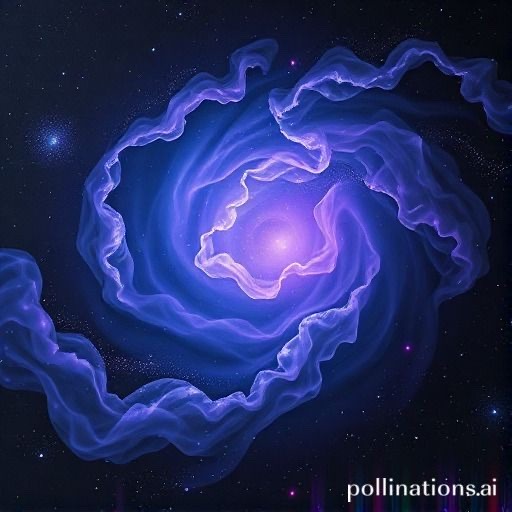
A critical aspect of galaxy clusters is the presence of dark matter, a mysterious and invisible substance that makes up most of the mass of these structures. The gravitational influence of dark matter is enormous, as it holds galaxies together in clusters and superclusters. In fact, most of the mass in galaxy clusters is dark matter, making it a dominant force in shaping the cosmic landscape.

The hot gas in dense galaxy clusters, the so-called intracluster medium, is a remarkable feature. Heated to millions of degrees, this gas emits X-rays that can outshine the light from individual galaxies. Studying this X-ray-emitting gas provides valuable insights into the temperature, density and overall mass distribution of the cluster. It is a powerful tool for astronomers to study the invisible dark matter and understand the dynamics of these massive structures.
As we travel through the local universe, we encounter superclusters, the largest known structures in the cosmos. Superclusters are vast collections of galaxy groups and clusters connected by galaxy filaments. They are the building blocks of the cosmic web, the complex network that spans the entire observable universe.

The Virgo Supercluster is our home supercluster, which contains the Local Group and the Virgo Cluster. It is a massive structure that spans 100 million light-years, making it a significant landmark in our cosmic neighborhood. The Virgo Supercluster is a crucial part of the larger Laniakea Supercluster, which defines our place in the cosmic web.
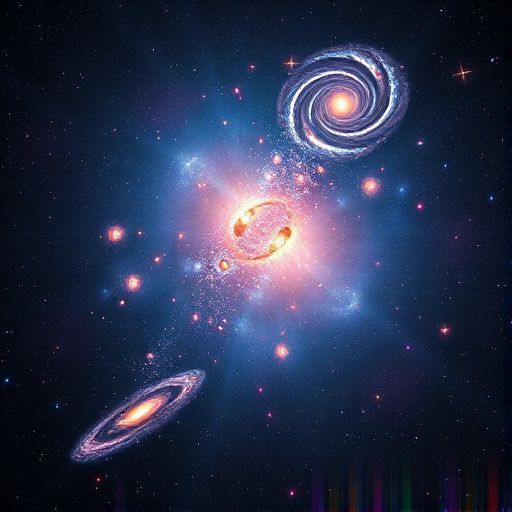
In 2014, astronomers defined the boundaries of the Laniakea Supercluster, a massive structure that encompasses and extends far beyond the Virgo Supercluster. Laniakea, which means "immeasurable sky" in Hawaiian, represents our cosmic home on a grand scale. Understanding superclusters like Laniakea is critical to mapping the large-scale structure of the universe and our place in it.
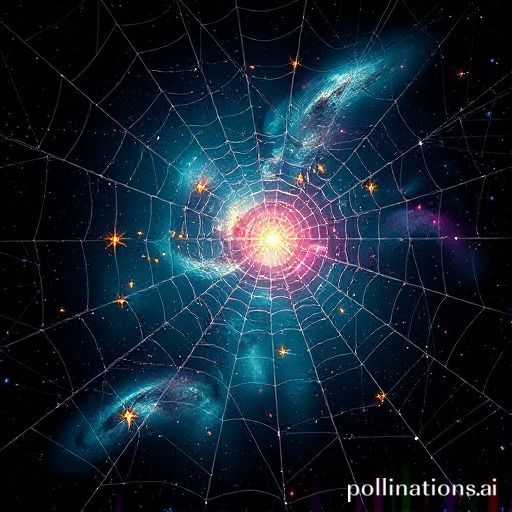
When we zoom in to even larger scales, we encounter the most extensive structures in the universe, including voids, filaments, and walls. These features form the cosmic web, a complex network that defines the distribution of matter in the universe.
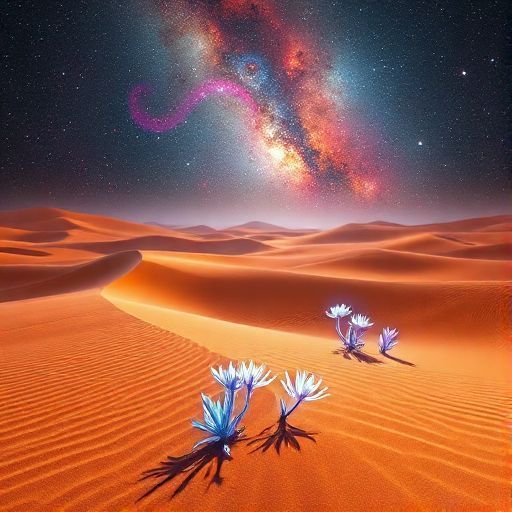
Voids are vast, empty regions of space with few or no galaxies. They are the cosmic deserts separated by the complex filaments and walls of the cosmic web. Voids can extend for hundreds of millions of light years and are crucial for understanding the large-scale structure and evolution of the universe.
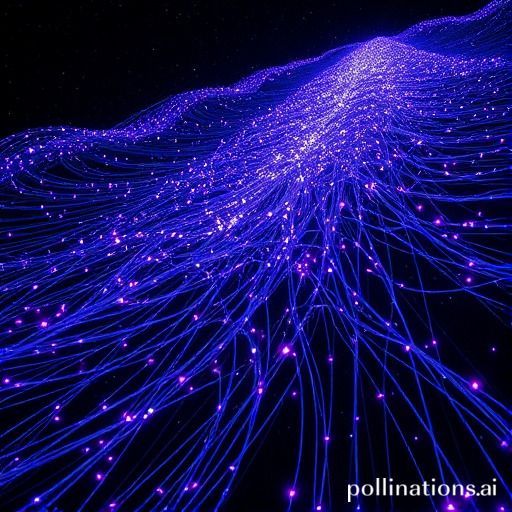
Filaments are long, thin structures that connect galaxy clusters and superclusters, while walls or sheets are relatively flat structures that contain numerous galaxies. These features form a cosmic fabric that determines the distribution of galaxies and superclusters. The "Great Wall" of Sloan, discovered by the Sloan Digital Sky Survey (SDSS), is a remarkable example of a huge sheet of galaxies that stretches for a billion light-years.

The Sloan Digital Sky Survey is a groundbreaking astronomical project that has revolutionized our understanding of the local universe and the cosmic web. SDSS has mapped the positions and distances of millions of galaxies, creating a detailed three-dimensional map of the cosmos. This survey has been crucial in identifying galaxy clusters, superclusters, and the complex filaments and voids that make up the cosmic web.
The local universe is a vibrant and dynamic environment filled with galaxies, groups, clusters, and superclusters. From the intimate interactions within the local group to the vast structures of the cosmic web, each element contributes to the grand narrative of the universe's evolution. Exploring the local universe allows us to understand our place in the cosmos and the complex relationships between celestial bodies. Studying galaxy groups, clusters, and superclusters provides valuable insights into the distribution of matter, the nature of dark matter, and the large-scale structure of the universe. As we continue to push the boundaries of astronomical research, the local universe will remain a crucial laboratory for testing our theories and expanding our knowledge of the cosmos. By unlocking the mysteries of our cosmic neighborhood, we come one step closer to understanding the vast and wondrous universe we inhabit.
Groups and Clusters of Galaxies (Jason Kendall, April 2024)
youtube
Where is Everything in The Universe Going? (History of the Universe, October 2024)
youtube
Sunday, October 13, 2024
#local universe#Youtube#galaxy groups#galaxy clusters#cosmic web#voids#filaments#astronomy#astrophysics#ai assisted writing#machine art#great attractor#presentation
2 notes
·
View notes
Photo

Hubble telescope captures the making of a 'cosmic monster' (photo) | Space
The massive cluster of galaxies lies about 8 billion light-years from Earth
The Hubble Space Telescope captured a massive cluster of galaxies, called eMACS J1353.7+4329, located about eight billion light-years from Earth in the constellation Canes Venatici. (Image credit: ESA/Hubble & NASA, H. Ebeling)
A "cosmic monster" is growing in a distant corner of the universe, and we just got a look at it.
The Hubble Space Telescope captured a stunning new view of a massive galaxy cluster called eMACS J1353.7+4329. This cluster lies about eight billion light-years from Earth in the constellation Canes Venatici. (For perspective, the farthest object ever observed lies 13.5 billion light-years from Earth.)
This galaxy cluster is "a monster in the making," consisting of at least two elliptical galaxy clusters in the process of merging together, according to a statement from the European Space Agency. (Hubble is a joint mission of NASA and ESA.) ...
2 notes
·
View notes
Text

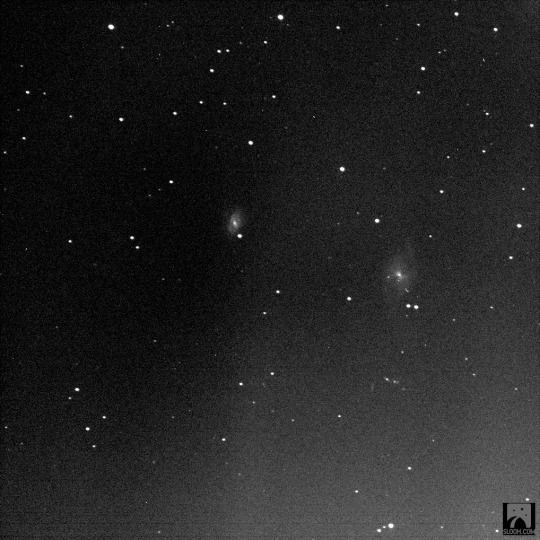
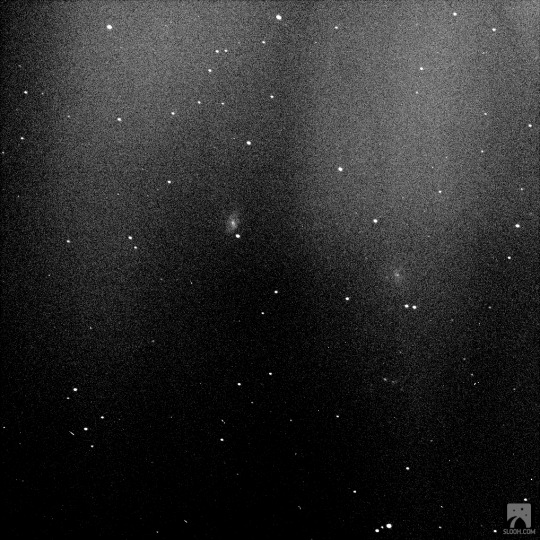

Big bear pair (ngc 3718/3729)
1 note
·
View note
Text

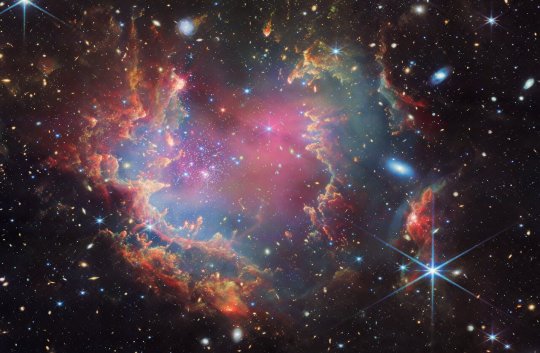
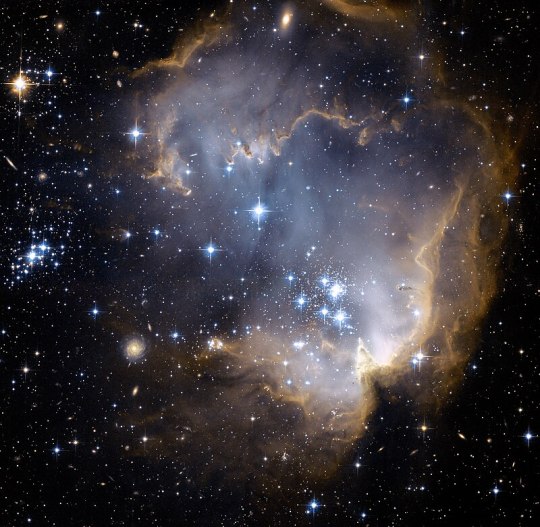
NGC 602, Star Cluster
5K notes
·
View notes
Text
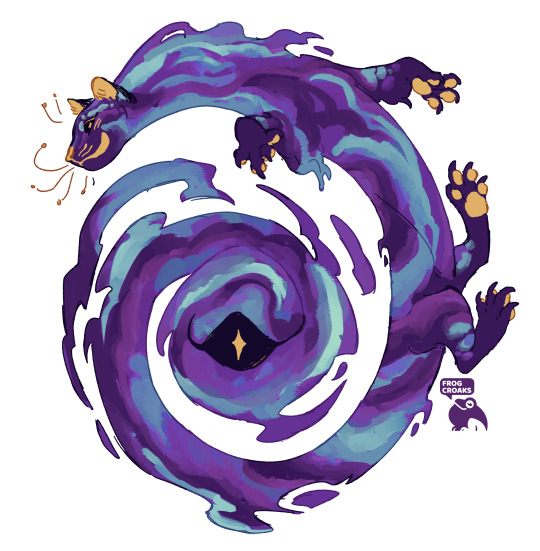
[design commission] The spirit of clairvoyance gazes towards you!
#my art#character design#furry art#commission#my designs#it is less of a solid body and more so a cluster of energy. almost similar to a galaxy#the eye at the center can predict the future of those it gazes at
3K notes
·
View notes
Text
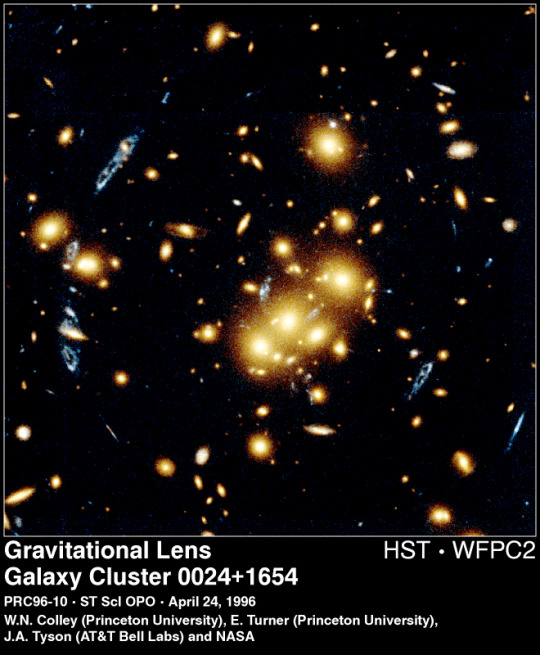
Giant Cluster Bends, Breaks Galaxy Images - April 24th, 1996.
"What are those strange blue objects? Many are images of a single, unusual, beaded, blue, ring-like galaxy which just happens to line-up behind a giant cluster of galaxies. Cluster galaxies here appear yellow and - together with the cluster's dark matter - act as a gravitational lens. A gravitational lens can create several images of background galaxies, analogous to the many points of light one would see while looking through a wine glass at a distant street light. The distinctive shape of this background galaxy - which was probably just forming - has allowed astronomers to deduce that it has separate images at 4, 8, 9 and 10 o'clock, from the center of the cluster. Possibly even the blue smudge just left of the center is yet another image! This spectacular photo from HST was taken in October, 1994. The first cluster lens was found unexpectedly by Roger Lynds (NOAO) and Vahe Petrosian (Stanford) in 1986, while testing a new type of imaging device. Lensed arcs around this cluster, CL0024+1654, were first discovered from the ground by David Koo (UCO Lick) in 1988."
95 notes
·
View notes
Text
Trixic flag colorpicked from galaxy cluster El Gordo and lensed background galaxies
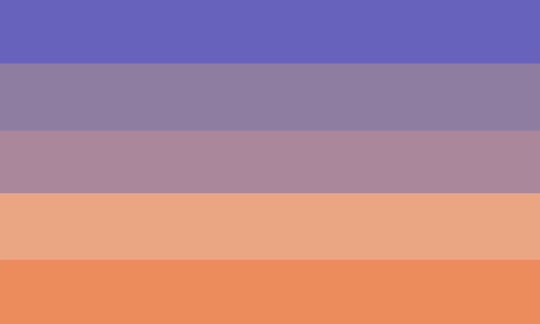

#color picked flags#color picked pride flags#james webb space telescope#jwst#color picked#colorpicked#colorpicked flags#colorpicked pride flags#jwst images#space#nasa#pride#pride flag#pride month#pride 2025#pride month 2025#trixic#galaxy#galaxies#galaxy cluster#galaxy clusters#gravitational lensing
8 notes
·
View notes
Text
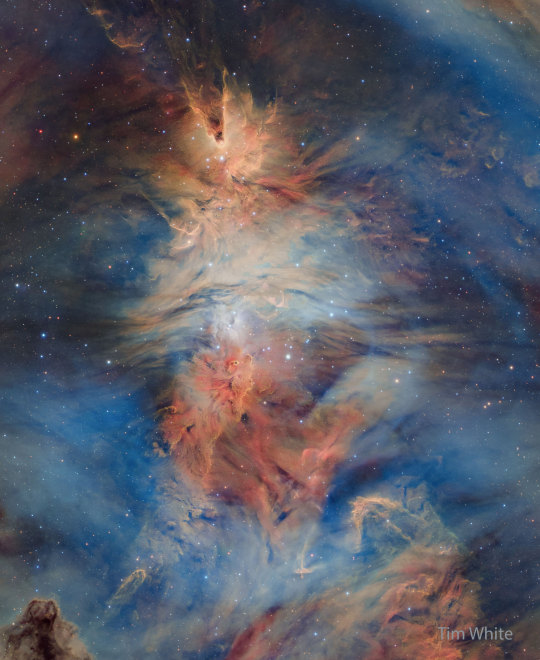
Fox Fur, Cone, and Christmas Tree ©
#space#astrophotography#stars#nebula#christmas tree cluster#christmas#planet#astronomy#solar system#galaxy#universe#cosmos#nasa#night sky
1K notes
·
View notes
Text

Westerlund 1, 12000 lys away l Webb
#stars#open cluster#space#astrophotography#astronomy#planets#webb#james webb space telescope#sky#galaxy#universe#solar system#nasa#westerlund 1
710 notes
·
View notes
Text

An article published in the journal Nature Astronomy reports the results of a study of seven galaxy clusters which contain various supermassive black holes that offers evidence that outbursts generated at these black holes help cool the gas they feed on. A team of researchers used observations with multiple instruments to examine seven galaxy clusters. Outbursts in the form of jets from the supermassive black holes in those clusters cool the gas by forming thin filaments. Some of that gas will eventually flow back toward those black holes, triggering more outbursts in a mechanism in which the black holes "cook" their own meals.
0 notes
Note

Laniakea, Pisces-Cetus Supercluster Complex, The Universe
#have you been here#poll#the universe#admin note: everyone's answer should be yes because the milky way galaxy is within this cluster
486 notes
·
View notes
Text




◾️▪️🖤Punk Space🖤▪️◾️
#gifs(edits) made by me :)#assassin1513#mystical#stars#lost in space#space#space vibes#space aesthetic#outer space#to infinity and beyond#infinity#punk#neon#beyond#nebula#star cluster#void#cosmos#dark#darkness#green#purple#black#blue#spacecore#space moodboard#space exploration#space ambient#universe#galaxy
760 notes
·
View notes